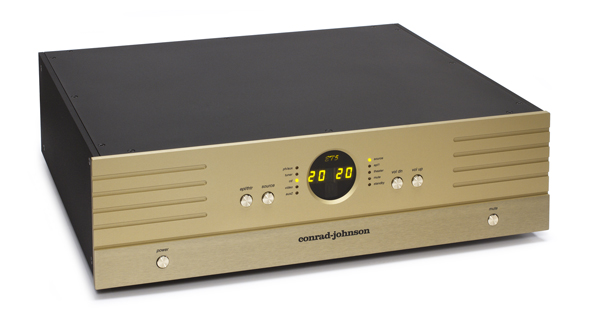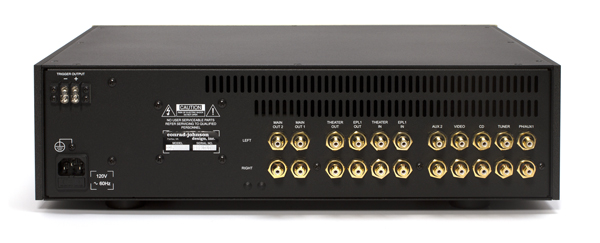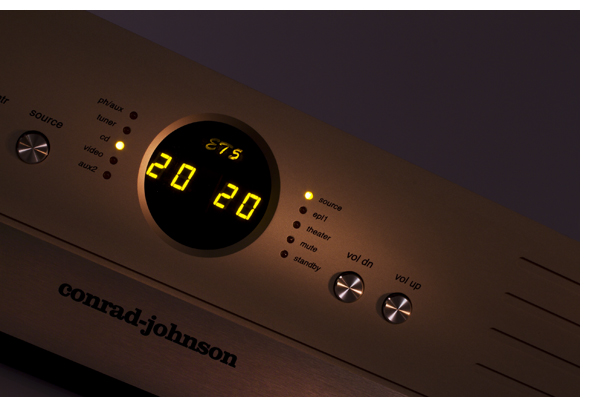Conrad Johnson ET5 Preamplifier One Step Beneath the GAT
By Jacob Heilbrunn Conrad-Johnson exudes stability. The look of its equipment never seems to radically change. The black top, the champagne face, the little silver buttons: All attest to a company that’s not fretting about its looks. Instead, it’s confident. But content and resting easy in the saddle? Not a chance. What’s taking place inside the box, of course, is what counts. And here, Conrad-Johnson makes some big changes. Bill Conrad and Lew Johnson, stalwarts of the high-end audio industry, are doing anything but resting upon their laurels. Instead, they seem intent on demonstrating that C-J remains on the cutting edge.
Conrad-Johnson exudes stability. The look of its equipment never seems to radically change. The black top, the champagne face, the little silver buttons: All attest to a company that’s not fretting about its looks. Instead, it’s confident. But content and resting easy in the saddle? Not a chance. What’s taking place inside the box, of course, is what counts. And here, Conrad-Johnson makes some big changes. Bill Conrad and Lew Johnson, stalwarts of the high-end audio industry, are doing anything but resting upon their laurels. Instead, they seem intent on demonstrating that C-J remains on the cutting edge.
The new ET5 preamplifier offers a case in point. It is the latest expression of C-J’s quest to refine the sound of its product line. Over the past decade, C-J has taken numerous steps to improve its preamplifiers and amplifiers, the heart of the company. It has made occasional forays into producing CD players, but tubed gear is its bread and butter.
Best of Both Worlds
C-J never abandoned the tube, and its traditional house sound has always emphasized musicality—a warm and fairly lush presentation, anything but coarse or grainy. But in recent years, the trend at C-J and elsewhere has leaned toward a more transparent sound. It used to be that musicality came at the expense of transparency, and vice versa. But that’s far from the case today. Very far, in fact. The truth is that improvements in capacitor technology have allowed audio companies to lower the noise floor to levels that might have seemed difficult, if not impossible, a mere decade ago.
After a series of highly regarded (and expensive) ART and ACT preamplifiers, C-J recently broke new ground with its GAT preamplifier, which is loaded with Teflon capacitors. It also employs a circuit design that for gain relies on the venerable 6922 tube. It seems that C-J, for reasons of sound or practicality, abandoned the Russian 6h30 tube that was introduced with much hue and cry, but which is no longer as easily obtained. C-J likes to use a single gain stage and mosfet buffer at the output with the ET5. In theory, using a mosfet is quieter and more reliable than employing a tube. (Although some tube lovers will always swear by the glowing bottle regardless of its position in the circuit.) C-J also makes a big deal about the fact that it doesn’t use electrolytic capacitors anywhere in its preamps—not even in the power supply. It’s a different approach. Electrolytics give you a lot of storage capacity, so they can be useful in power supplies.
That said, few companies disdain them to the extent that C-J does. But C-J feels they degrade the sound, and there’s no doubting that, if possible, electrolytics are best avoided. In addition, the single gain stage in the company’s preamplifiers means that it inverts phase, which, in turn requires reversing the polarity of your speaker cables if you are not using a power amplifier that also inverts phase, as C-J amplifiers do. C-J has always preferred the simplicity of a single-ended design as opposed to the complexity of a fully balanced design. Moreover, all C-J gear is single-ended, which means no doubling of parts, as in a balanced design. C-J’s attitude: Why complicate the gear more than necessary?
Hence, the ET5 is the lineal descendant of the much-extolled GAT. But does it sacrifice too much to be even mentioned in the same breath? Not way. And it weighs in at the much more affordable price of $9,500.
The ET5’s winning qualities are immediately apparent. For its price, you deserve transparency, rock-solid imaging, and beauty. The ET5 delivers them all. It does a great job of balancing a somewhat mellow sound with transparency. And that mellowness comes through beautifully on instruments such as flute. Vide, MA Recordings’ stellar CD featuring Diana Baroni playing Johann Sebastian Bach’s flute sonata. This might sound like another fusty, old baroque recording, but believe me, it isn’t. And through the ET5, it truly sounds alive. The ET5 brings to the table a wonderfully rich shower of harmonic overtones. I could practically hear the flute vibrating, every breath that the performer took, all the details that take a performance from the mundane to the sublime. Pure artistry.
Ditto for another of my favorite flute recordings, this one featuring Joshua Smith on a Delos CD. I could practically see Smith’s fingers whizzing up and down the flute as they hit the keypads. The ET5 suffused my room with music, drenched it with harmonics, buzzing sounds, and plangent cellos. The amount of air it produces around instruments? Nothing short of sensational. One easily gets the feeling that the concert stage is right there in front of you.
The ET5’s ability to nail the timbral signature of an instrument equates to another strong point. Many have been the times that I have listened to a recording of multiple trumpets called—what else?—“Baroque Trumpetissimo.” It features an all-star cast, including Raymond Mase and Edward Carroll. These guys can pretty much do anything on the horn, and the ET5 really let me hear how they strut their stuff. Particularly impressive is the facility with which the ET5 allows the initial intonation to come through; that silvery pop signals that a master trumpeter is at work.
Then there is image stability. The ET5 excels at it. With this preamp, you can focus on the performers’ position to your heart’s content. And this particular virtue is probably a product of the preamps’ exceptionally low grain. It simply doesn’t smear the images, but opens up a huge and panoramic soundstage.
The Question of Power
Where does the ET5 come up a little short? That’s easy to answer. It doesn’t pack the punch of its bigger brethren. Preamps retailing for $20K and up—which, believe it or not, has become the routine price for top-drawer models—have more sonic power and impact. My Messenger preamplifier claims more heft and grandeur. But go to the GAT, and you’ll get that as well. Why? The secret, as always, is in the power supply. More capacitance usually means more acoustic thunder. If a preamp is going to navigate complicated passages with aplomb, it needs plenty of dynamic reserves. In audio, you get what you pay for, and sometimes, a little more.
The ET5 unquestionably lands on the “more” side of the equation. This unassuming preamplifier is a quietly devastating piece of equipment, one that may force you to rethink the limits of sonic reproduction, particularly at its price. One of the things that tends to get lost in the audiophile shuffle is that recordings to which many audiophiles listen can feature some pretty amazing playing. However, audiophiles often get distracted by sheer sonic effects as opposed to instrumentalists’ virtuosity.
For my money, the ET5 represents a significant step forward for C-J. Without sacrificing the mellifluous sound that is its trademark, C-J demonstrates that its new products can deliver a transparent sound and more. Anyone looking for a high-end preamp that’s linear, musical, reliable would do well to consider the ET5. It does nothing wrong and pretty much everything right.
By Jeff Dorgay
Having logged experience using C-J’s ACT 2 series 2 preamplifier for a number of years as a reference component, and having spent considerable time with the CT5 and ART series of preamplifiers (series 1, 2 and 3), the ET5 emerges as an entirely different animal. Even when taking the ART preamplifiers into account, my favorite series has always been the ACT 2, because of the combination of tonal accuracy and dynamic contrast it provides.
If you’ve had a chance to experience the GAT, it is truly the pinnacle of C-J preamplifier design—and perhaps the pinnacle of preamplifier design, period. The ET5 comes shockingly close to it for less than half the price and offers a similar tonal rendition. Listeners with world-beater systems will happily belly up for the GAT, if for nothing else than the bragging rights. And, it genuinely is a step above the ET5. But those happy to reside one step down from the true audio maniacs will be equally happy to keep the additional $10,500 in their pocket.
A Quick Comparison
Since I utilized the ET5 in an-all CJ system with a Premier 350 power amplifier and GamuT S9 speakers, it was rather easy to compare the new model to the ACT 2. Of course, there will always be a difference in sound between anything based on the 6922/6DJ8 tube versus the 6H30. The former possesses a slightly softer and warmer sound than the 6H30, which usually offers more authority in the lower end as well as more punch.
The ET5’s hybrid design brings the two preamplifiers closer together in tonal rendition, and offers an even quieter background than the ACT 2—not dramatic, but enough that those enjoying classical and small-ensemble acoustic pieces will definitely take notice. Listening to David Grisman’s Hot Dawg at a realistically live level via the ACT 2 yielded a bit of tube noise in the interludes. There was markedly less of the latter when I played the disc played through the ET5. Advantage, ET5.
Thanks to only one 6922 tube, the ET5 is easier to manipulate than any other vacuum-tube preamplifier going. When you only have to buy one tube, those $300 Telefunkens and $200 Bugle Boys become more interesting. Considering every C-J tube preamplifier I’ve owned since 1978 has been easy on tubes, I’m going to assume the ET5 will continue in that tradition.
While the ET5 sounds just fine with the stock tube, another world awaits you with aftermarket tubes. The EAT ECC88 is quite possibly the best choice since it does not alter the tonality of the preamplifier; it just offers up more dynamic punch and a lower noise floor. After installing the EAT, I went back to the Grisman record and discovered zero tube noise in the background. The EAT tube also threw a bigger soundstage in all three directions and had more bass weight. When listening to the title track from Thievery Corporation’s recent LP, Culture of Fear, the upgraded tube yielded deeper bass beats with more grip.
Swapping the EAT for a rare Telefunken CCa sacrificed some transient speed but gave the midrange an intoxicating opulence, especially with my favorite 60s rock records. Jimi Hendrix’s Are You Experienced? proved a revelation. I now truly was experienced. Similar sensations came courtesy of Incredible Hog’s “To The Sea,” a track from the band’s self-titled album. It was as if I had x-ray vision and could just see the plate reverb vibrating inside one of the group’s Orange amplifiers.
Lew Johnson and Bill Conrad are primarily classical music guys, yet they may have inadvertently created the world’s most incredible rock n’ roll preamplifier with the ET5/Telefunken combination. And while we don’t recommend using tube swapping as a tone control, it’s nice to know you have the option. (Guitar players have been doing it for years, so why not?) With this being such an easy process, the advantage again goes to the ET5.
In terms of dynamics, the ACT 2 is still the king. Whether I was listening to the Who or Shostakovich, the ET5 didn’t as effortlessly move the big air as did the ACT 2. Via the latter, drum thwacks had more punch and were better defined, both on the leading and trailing edge of the sound.
Ladies and Gentlemen, We Have a Winner
The toughest part of describing expensive audio equipment is the degree of importance one should place upon the gear. To many, the difference between C-J’s best may not be quite as dramatic as it is to those that are somewhat more maniacal. Whether you choose to experiment with the tubes or not, the new ET5 remains an outstanding preamplifier in every aspect. Those well-versed with the C-J of old—with a warmer, more romantic sound—may long for the euphonic coloration those units provide.
Personally, I love the current C-J sound. It offers up almost all of the tonal richness that made the company famous, yet adds the dynamic capabilities of a modern preamplifier. Thanks to the CJD Teflon capacitors and a single tube, the ET5 should last even longer than my PV-1, which is still in service after 33 years. I can only think of about six preamplifiers that outperform the ET5. They all have a price that costs two-to-five times greater, and half of them are C-J designs. If that doesn’t say Exceptional Value Award for 2011, nothing does. Highly recommended.
Conrad-Johnson ET5 Preamplifier
MSRP: $9,500
Peripherals
| Analog Source | Continuum Caliburn w/2 Cobra tonearms AirTight PC-1 Supreme (Stereo) Lyra Titan (Mono) |
| Preamplifier | Messenger |
| Power Amplifier | Classe CA-M600 Monos (two more for subwoofers) |
| Speakers | Wilson Audio Alexandria X-2 w/Thor Subwoofers Magnepan 20.1 |
| Cable | Jena Labs Analord Prime Phono Cable |
| Power | Isoclean Supreme Focus Stage III Concepts |





